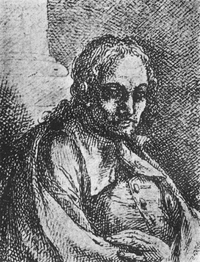Battistello Caracciolo
| Battistello Caracciolo | |
|---|---|

Portrait drawing which Onofrio Giannone presumed to be of Caracciolo and published in 1773 (Museo Civico Filangieri, Naples).
|
|
| Born |
Giovanni Battista Caracciolo December 7, 1578 Naples |
| Died | December 23, 1635 (aged 57) Naples |
| Nationality | Italian |
| Education | Francesco Imparato, Fabrizio Santafede |
| Known for | painting, fresco |
| Movement | Caravaggism |
| Spouse(s) | Beatrice de Mario |
Giovanni Battista Caracciolo (also called Battistello) (1578–1635) was an Italian artist and important Neapolitan follower of Caravaggio.
The only substantial early source of biography is that of Bernardo de' Dominici's unreliable publication of 1742. De Dominici's statements are often contradicted by documented facts and others cannot be substantiated independently. Archival documents state Caracciolo was born in Naples and baptised on 7 December 1578, as the son of Cesare Caracciolo and his wife Elena. The family lived in the parish of San Giovanni Maggiore.
On 3 August 1598, at the age of twenty, Caracciolo married Beatrice de Mario. They had ten children, of whom eight survived to adulthood.
His initial training was said to be with Francesco Imparato and Fabrizio Santafede, but the first impulse that directed his art came from Caravaggio's sudden presence in Naples in late 1606. Caravaggio had fled there after killing a man in a brawl in Rome, and he arrived at the end of September or beginning of October 1606. His stay in the city lasted only about eight months, with another brief visit in 1609/1610, yet his impact on artistic life there was profound.
Caracciolo, only five years younger than Caravaggio, was among the first there to adopt the startling new style with its sombre palette, dramatic tenebrism, and sculptural figures in a shallow picture plane defined by light rather than by perspective. He is considered to be the solitary founder of the Neapolitan school of Caravaggism. Among the other Neapolitan Caravaggisti were Giuseppe Ribera,Carlo Sellitto, Artemisia Gentileschi, and Caracciolo's pupil, Mattia Preti, then early in his career.
Caracciolo's Caravaggesque phase was fundamental to his entire career. His first contact with Caravaggio must have been around the time of the Radolovich commission, dated 6 October 1606, and the contacts continued through Caravaggio's completion of the Seven Works of Mercy during the last months of that year and early 1607. A notable result of Caravaggio's influence is Caracciolo's The Crucifixion of Christ, with its strong echoes of the Crucifixion of Saint Andrew.
...
Wikipedia
